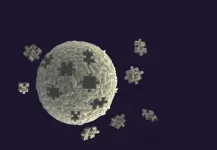(Press-News.org) Five years ago, scientists created a single-celled synthetic organism that, with only 473 genes, was the simplest living cell ever known. However, this bacteria-like organism behaved strangely when growing and dividing, producing cells with wildly different shapes and sizes.
Now, scientists have identified seven genes that can be added to tame the cells' unruly nature, causing them to neatly divide into uniform orbs. This achievement, a collaboration between the J. Craig Venter Institute (JCVI), the National Institute of Standards and Technology (NIST) and the Massachusetts Institute of Technology (MIT) Center for Bits and Atoms, was described in the journal Cell.
Identifying these genes is an important step toward engineering synthetic cells that do useful things. Such cells could act as small factories that produce drugs, foods and fuels; detect disease and produce drugs to treat it while living inside the body; and function as tiny computers.
But to design and build a cell that does exactly what you want it to do, it helps to have a list of essential parts and know how they fit together.
"We want to understand the fundamental design rules of life," said Elizabeth Strychalski, a co-author on the study and leader of NIST's Cellular Engineering Group. "If this cell can help us to discover and understand those rules, then we're off to the races."
Scientists at JCVI constructed the first cell with a synthetic genome in 2010. They didn't build that cell completely from scratch. Instead, they started with cells from a very simple type of bacteria called a mycoplasma. They destroyed the DNA in those cells and replaced it with DNA that was designed on a computer and synthesized in a lab. This was the first organism in the history of life on Earth to have an entirely synthetic genome. They called it JCVI-syn1.0.
Since then, scientists have been working to strip that organism down to its minimum genetic components. The super-simple cell they created five years ago, dubbed JCVI-syn3.0, was perhaps too minimalist. The researchers have now added 19 genes back to this cell, including the seven needed for normal cell division, to create the new variant, JCVI-syn3A. This variant has fewer than 500 genes. To put that number in perspective, the E. coli bacteria that live in your gut have about 4,000 genes. A human cell has around 30,000.
Identifying those seven additional genes took years of painstaking effort by JCVI's synthetic biology group, led by co-author John Glass. Co-lead author and JCVI scientist Lijie Sun constructed dozens of variant strains by systematically adding and removing genes. She and the other researchers would then observe how those genetic changes affected cell growth and division.
NIST's role was to measure the resulting changes under a microscope. This was a challenge because the cells had to be alive for observation. Using powerful microscopes to observe dead cells is relatively easy. Imaging live cells is much harder.
Holding these cells in place under a microscope was particularly difficult because they are so small and delicate. A hundred or more would fit inside a single E. coli bacterium. Tiny forces can tear them apart.
To solve this problem, Strychalski and MIT co-authors James Pelletier, Andreas Mershin and Neil Gershenfeld designed a microfluidic chemostat -- a sort of mini-aquarium -- where the cells could be kept fed and happy under a light microscope. The result was stop-motion video that showed the synthetic cells growing and dividing.
One video shows JCVI-syn3.0 cells -- the ones created five years ago -- dividing into different shapes and sizes. Some of the cells form filaments. Others appear to not fully separate and line up like beads on a string. Despite the variety, all the cells in that video are genetically identical.
Another video shows the new JCVI-Syn3A cells dividing into cells of more uniform shape and size.
These videos and others like them allowed the researchers to observe how their genetic manipulations affected the cell growth and division. If removing a gene disrupted the normal process, they'd put it back and try another.
"Our goal is to know the function of every gene so we can develop a complete model of how a cell works," Pelletier said.
But that goal has not been reached yet. Of the seven genes added to this organism for normal cell division, scientists know what only two of them do. The roles that the other five play in cell division are not yet known.
"Life is still a black box," Strychalski said. But with this simplified synthetic cell, scientists are getting a good look at what's going on inside.
INFORMATION:
The two files attached to the release are gifs. Download the files as a reporter registrant or email the media contact for the original files.
Maternal socioeconomic status impacts babies even before birth, emphasizing the need for policy interventions to support the wellbeing of pregnant women, according to newly published END ...
PHILADELPHIA -- The U.S. government's Special Supplemental Nutrition Program for Women, Infants, and Children, usually abbreviated as WIC, saw a jump in enrollment of nearly 8 percent in states that implemented a federally mandated switch from paper vouchers to electronic benefit cards (EBTs), according to a study led by researchers at the Perelman School of Medicine at the University of Pennsylvania.
The finding, published in JAMA Pediatrics, supports the rationale for the switch, which was to increase participation by making it easier and less stigmatizing to obtain and redeem WIC benefits.
"The broad takeaway ...
Around one in 57 (1.76%) children in the UK is on the autistic spectrum, significantly higher than previously reported, according to a study of more than 7 million children carried out by researchers from the University of Cambridge's Department of Psychiatry in collaboration with researchers from Newcastle University and Maastricht University.
Black and Chinese pupils were 26% and 38% more likely to be autistic respectively and autistic children were much more likely to face significant social disadvantage. The results are published today in JAMA Pediatrics.
The team drew on data from the School Census from the National Pupil Database, collected by the Department for Education from individuals aged 2-21 years old in state-funded schools in England. Of more than 7 million ...
What The Study Did: This comparative effectiveness study investigates how the COVID-19 pandemic is associated with the benefits and risks of standard radiation therapy in simulated patients.
Authors: Rifaquat Rahman, M.D., of the Dana-Farber/Brigham and Women's Cancer Center in Boston, is the corresponding author.
To access the embargoed study: Visit our For The Media website at this link https://media.jamanetwork.com/
(doi:10.1001/jamanetworkopen.2021.3304)
Editor's Note: The article includes conflict of interest disclosures. Please see the article for additional information, ...
BOSTON --Medical professionals often advise patients not to search the Internet for their symptoms before coming into the clinic, yet many people turn to "Dr. Google" when feeling sick. Concerns about "cyberchondria" -- or increased anxiety induced by the Internet -- have made the value of using Internet searches controversial. In a new study that used case vignettes, researchers from Brigham and Women's Hospital and Harvard Medical School Department of Health Care Policy explored the impact Internet searches have on patients' abilities to reach a correct diagnosis. They found that study outcomes suggest the Internet may not be so harmful after all. Participants ...
Younger age of first cannabis use or prescription drug misuse is associated with faster development of substance use disorders
NIH analysis measures the prevalence of nine substance use disorders after first substance use or misuse in young people
A new study shows that in the time after first trying cannabis or first misusing prescription drugs, the percentages of young people who develop the corresponding substance use disorder are higher among adolescents (ages 12-17) than young adults (ages 18-25). In addition, 30% of young adults develop a heroin use disorder and 25% develop a methamphetamine use disorder a year after first using heroin or methamphetamine. These findings, published in JAMA Pediatrics, emphasize the vulnerability ...
A hydrogel, a type of soft matter, developed at Hokkaido University successfully reverted cancer cells back to cancer stem cells within 24 hours, in six different human cancer types. This could lead to the development of anti-cancer stem cell drugs and personalized medicines.
An innovative hydrogel - called a double network (DN) gel - can rapidly reprogram differentiated cancer cells into cancer stem cells, researchers at Hokkaido University and the National Cancer Center Research Institute have reported in the journal Nature Biomedical Engineering. The hydrogel can be used to help develop ...
A new black hole breaks the record -- not for being the smallest or the biggest -- but for being right in the middle.
The recently discovered 'Goldilocks' black hole is part of a missing link between two populations of black holes: small black holes made from stars and supermassive giants in the nucleus of most galaxies.
In a joint effort, researchers from the University of Melbourne and Monash University have uncovered a black hole approximately 55,000 times the mass of the sun, a fabled "intermediate-mass" black hole.
The discovery was published today in the paper Evidence for an intermediate mass black hole from a gravitationally lensed gamma-ray burst in the journal Nature Astronomy.
Lead author and University of Melbourne PhD student, ...
In the last few years, as climate changes continues to become more severe, there has been a growing push for rich countries to pay poorer ones to preserve and protect rain forests and other tropical forests. However, according to a new study in Nature Ecology & Evolution, RIHN Associate Professor Keiichiro Kanemoto and Senior Researcher Nguyen Tien Hoang show that other financial motives, namely international trade, with these same rich countries have actually encouraged poorer countries to increase their annual deforestation levels from 2001 to 2015.
Every year ...
CAMBRIDGE, MA - Using an ordinary light microscope, MIT engineers have devised a technique for imaging biological samples with accuracy at the scale of 10 nanometers -- which should enable them to image viruses and potentially even single biomolecules, the researchers say.
The new technique builds on expansion microscopy, an approach that involves embedding biological samples in a hydrogel and then expanding them before imaging them with a microscope. For the latest version of the technique, the researchers developed a new type of hydrogel that maintains a more uniform configuration, allowing for greater accuracy in imaging tiny structures.
This degree of accuracy ...



